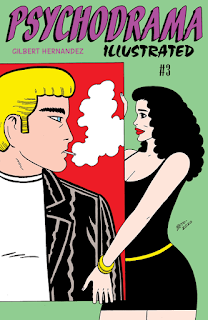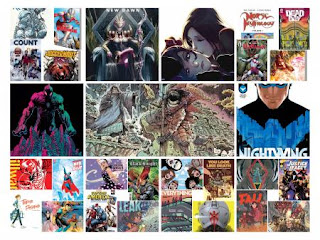ALL NEW ALL STAR RECOMMENDS #1
MARCH 2021
Cameron Ashley
Hi There,
I’m Cam. Been a
while, huh? Excuse me as I shake off the column-writing rust right here and I
should be back in May, if not before, a little fitter in the writing
department.
I’ve changed
things up quite a bit around here, hope you like the new format.
FEATURED
COMIC:
PSYCHODRAMA
ILLUSTRATED #3-#4
Gilbert
Hernandez
Fantagraphics

Brothers Gilbert
and Jaime Hernandez hold reputations as two of the world’s greatest living
cartoonists. Despite ongoing, decades long acclaim for both Los Bros Hernandez,
it’s Jaime, with his gorgeous and dare I say it, more commercially appealing
linework who remains the higher profile of the two. As evidence, there’s
Jaime’s illustration work, the magazine covers, the monographs, the studio
editions. Not to mention the fact that we really only see his beautiful
sequential work in quarterly instalments of Love & Rockets. The arrival of
new Jaime work almost feels like an event.
Gilbert, on the
other hand, not only toils away on L&R but has amassed a huge body of
comics work outside of that world. He’s prolific, versatile and unafraid to
take huge creative risks. He’s also quite possibly taken for granted a bit.
While Jaime’s
work has evolved gorgeously over the 35-plus years of Love & Rockets
history, Gilbert’s has also, just in much different ways. While Jaime has
refined an illustrative lushness, Gilbert has simplified and somewhat
abstracted his style. It’s become looser, cartoonier and surely much quicker to
produce as his large output might signal. Not only is there so much of
Gilbert’s work, the range of it is giant - the incredible drama of Julio’s Day,
the true life-tinged Marble Season, the
zombie splatter of Fatima: The Blood Spinners, the absurdity of Blubber and
wild sexuality found in Garden of The Flesh or the best porno comic ever,
Birdland, for example.
A fairly
constant presence on comic shop shelves, over the years Gilbert’s created work
for not just L&R publisher Fantagraphics, but also Drawn and Quarterly,
Dark Horse, Vertigo and he even wrote a brief run of DCs Birds of Prey comics
in 2003. He’s been everywhere, making zombie comics, porno comics, surreal
Lynchian comics, crime comics, semi-autobiographical comics, coming of age
comics, superhero comics, Simpsons comics, underground comics, comics
“remaking” his own comics, he’s done it all. He began his career almost touted
as comics’ own Gabriel Garcia Marquez, a Literary Magical Realist, but his much
of subsequent work over the years could well be read as a rebellion against
that as obvious B-Movie influences frequently shoved the more Literary ones
aside.
Psychodrama
Illustrated is Hernandez’s most recent “other” ongoing work aside from Love
& Rockets. It “adapts” the films of Rosalba “Fritz” Martinez, half sister
of the legendary Luba and one of Gilbert’s most enduring L&R characters,
while also expanding upon the family history of Fritz and co. It’s a series
that essentially cuts Hernandez loose - under the conceit of creating Fritz’s
“fictional” films, he can tell any story he likes, in any genre, in any style.
Issue #1 intercut of “real life” with a kind of blu ray commentary track
playing over sequences of a film called “Hypnotwist 2.0” (itself a “remake” of
Hypnotwist which you can find in hardcover now) starring Fritz’s grandniece,
Killer. Issue #2 is the lurid “Mercy and The Devil,” a B-movie in which Fritz
and Killer star as “an ex-adult actress and her grifter niece.” It’s playful, mind-bending stuff from
Hernandez, recasting his characters again and again like a grindhouse Tezuka
but never losing the threads of their “reality” and their own lives.
It’s issues
#3-#4, however, that serve as a reminder of just how skilled a creator Gilbert
Hernandez is. Spread over two single issues, “Little Ones” sees Fritz forced
into the background, under heavy make-up and happily playing a supporting role.
It’s a story that can, and should, be read as a complete stand-alone. It also
shows Gilbert’s storytelling skills at their absolute peak, the kind of
zero-fat comics he excels at where any extraneous, unnecessary story-baggage is
shorn off.
“Little Ones” is
an engine of comics and a masterclass of comics craft and story editing made
even more remarkable by just how easy Hernandez appears to make this look. Told
without captions, with an average of four very open panels per page, Hernandez
spins a complex drama with baffling control, bringing to vivid life a cast of
around 20 brand new characters.
Let me attempt
to summarise:
Near the Mexican
border lies a small town known as Lagrimas. “Lagrimas means tears” we are told
throughout “Little Ones,” the perfect summation of Hernandez’s noirish
melodrama. Two small, lost, malnourished and possibly orphaned children, one
boy and one girl, sneak their way into town. Fearful of being seen, more
fearful still of any authority, the children hide out in Lagrimas, eating out
of bins and desperately brainstorming ways to survive. Trump’s wall, conceived
to divide Mexico from the US, is on its way. Town resident Sal plans to protest
the wall, but there is division in town - the wall means labor, labor means
money. Why should Lagrimas residents miss out on a pay check, particularly when
Mr. Paz works for contractors rumoured for the job? Many townsfolk aren’t
concerned at all about the wall, in fact there is a kind of inevitable support
for it, as voiced by Alma, who taunts the Mexican-American kids in town with
barbs like, “They’re going to kick you and all latinos out of the country any
day now, stupid.”

Against the
backdrop of the combined racial and
economic tension the rumoured wall creates, Zak ekes out a living trying to
sell drugs to townsfolk who can’t afford them while his wife Grace cleans
houses bringing in enough to ensure their young son Rocky is fed. Sal becomes
further determined to protest the wall, causing strife with his wife Nina who
has taken to secretly feeding the lost boy and girl. Then there is “business
owner” Castor who has a family of his own and while he hovers around the
periphery, as things darken considerably his role in what unfolds deepens and
we learn once and for all that Lagrimas truly does mean tears.
Clearly, “Little
Ones” has a lot of characters to keep track of (there are more I’ve not even
mentioned) and a lot of story to tell. It has a deep, complex conflict
surrounding a very real life issue and touches on everything from refugees (or
“illegals” in this case, if you will), to racial issues, to the unfortunate
economic impoverishment of the working class. It builds all these characters
throughout and spirals into a fairly shocking climax.
It somehow
manages to do all this over a mere 50 pages, many of which are as decompressed
and breezy to read as a fight sequence from The Authority. It’s Hernandez’s
skill at picking the right moments to depict, dropping us into the exact
snippets of ongoing conversations to give us exactly the information readers
need that makes this all work but it’s still a pretty astonishing feat.
So quickly does
the first chapter of “Little Ones” float by that I only truly understood how
rich the story was when I first opened issue #4 (I read both issues for the
first time back-to-back), found the below recap page and realised just how much
the opening chapter had miraculously stuffed between its covers like some sort
of magic comics girdle.
All these
characters exist in the here and the now - the is no backstory for anybody, no
room for expository flab. Our mystery kids are exactly that - a mystery, just
two lost kids in need of immediate and ongoing care. Are they illegal
immigrants? Have the escaped something truly sinister? We never truly know.
I was taught
that the best (literary) short stories exist in a kind of middle place, freed
from the almost narrative baggage of past or future, and “Little Ones”
exemplifies this perfectly. This is the kind of story that easily could be 100
pages formatted into a deluxe graphic novel, but at half that length divided
into two regular comic books, “Little Ones” somehow never feels at all rushed
and its quiet moments are as plentiful as its dramatic ones.
In terms of the
story editing, this is possibly the sharpest Hernandez has been in quite some
time and that’s saying something. Let’s compare with another Hernandez
classic, 2013’s Julio’s Day, to see how
much Hernandez’s work has evolved. Julio’s Day tells the titular character’s
century-spanning life, from beginning to end, in exactly that many pages (the
narrative opposite of the “middle” of “Little Ones” ). The fact that “Little
Ones” is as lean as it is shows just how ruthless the artist has become with
his editing over the years. “Little Ones’” pages are far more open and
frequently “widescreen” than Julio’s Day. Almost reflecting the leanness of
this story (and other more recent works), the fat inky brushstrokes of Julio’s
Day have been largely swapped out for comparatively fine, thin lines showing far
more of the stark whiteness of the page - cartooning as stripped back as story.
Don’t sleep on
Psychodrama Illustrated. It may lack the pop culture cachet of having “A Love
& Rockets Book” somewhere above the logo, but as “Little Ones” proves, even
after thousands of comics pages and hundreds of stories, Gilbert Hernandez
maintains his status as a maker of utterly unmissable comics.
WHAT
MADNESS IS THIS: STRANGE THINGS FROM THE SHELF
ULYSSES
Jacques Lob
& Georges Pichard
Heavy Metal
From writer
Jacques Lob and artist Georges Pichard’s mind-bending, marvellously trashy and
lurid in all the right ways Ulysses comes this saucy, psychedelic panel.
Originally published in the pages of Metal Hurlant in 1974, the 2006 collection
from Heavy Metal is not too hard to
source should you need yourself a four colour fix. It’s basically Homer’s
classic The Odyssey undergoing a glorious mid-70s drug-chic drenching. Amazing.
UPCOMING
UNDER THE RADAR
IN PICTOPIA
Don Simpson,
Mike Kazalah, Pete Poplaski, Eric Vincent and Alan
Moore The Writer
Fantagraphics
Due April
So in 1986, a
very popular writer by the name of Alan Moore wrote a little 8 page number
called “In Fictopia.” It was published in #2 of a six-issue benefit book
Fantagraphics published to help pay some hefty legal bills accrued after writer
Harlan Ellison colourfully called writer Michael Fleischer, ahem, “bugfuck” and
“derango” in the Comics Journal and Fleischer sued.
Prior to
publication, artist Don Simpson (along with Kazalah, Poplaski and Vincent)
changed the title to “In Pictopia” (which let’s face it, is better) and
expanded it out to 13 pages. It’s one of Moore’s oldest rallying cries against
the people in charge of the medium, with thinly-veiled analogues of various
comic book character tropes populating a city that was once a comic book
utopia, now exploited and ghettoised, a place where once thriving boroughs are
demolished as they “just don’t fit the continuity no more.”
Considered
something of a lost classic for decades now, In Pictopia is finally celebrated
in a new oversized, remastered 28 page edition arriving end of April. Moore’s
involvement with the book has been downplayed - even Fantagraphics’ advertising
simply states “written by the era’s most adventurous mainstream writer” -
likely because of how heavily Simpson took over the creative. But make no
mistake, with Moore’s recent retirement there aren’t too many more works by
arguably the best comics writer ever to be unearthed, particularly a work as
celebrated and long lost as this.
See you soon.
Read Indie.













